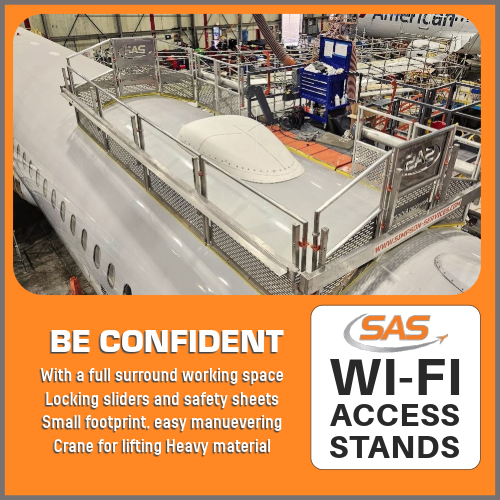(It’s a new year and good time to repeat this information from the National Aviation Academy. SAS doesn’t have operating aircraft at our facility, but these practices apply to our daily routine. When we go on-site (which is often), it’s especially important to be mindful of these guidelines.)
Use the Correct Tools & Equipment
The aviation mechanic toolset often includes unique tools for specific tasks. When presented with these tasks, mechanics should avoid improvised situations as any cut corners can lead to a compromised result and thus endanger both the mechanic and the aircraft.
Additionally, the condition of tools should be checked regularly. Tools used past their expected lifespan can easily break or malfunction, leading to injury. The same is true for the access stands and platforms. Mechanics reaching beyond their range or stretching to use equipment not intended for the job, present added risk to an operation and its people.
Wear Proper PPE
Personal protective equipment, or PPE, is essential to an aircraft maintenance technician’s arsenal. The type of PPE needed usually varies with a given task.
Examples of commonly used PPE in aviation maintenance include:
Hard caps – Worn to prevent head collisions, especially with falling parts.
Face and eye coverings – Worn to protect the face from flyaway particles.
Coveralls and rubber gloves – Worn to protect the body and hands from hazardous chemicals.
Protective footwear – Steel-toe shoes provide excellent protection when handling objects that can be dropped. Footwear should also be non-slip to prevent falls.
Fume extractors – This tool absorbs soldering fumes that can present long-term health risks if inhaled regularly.
Respirators – Worn while performing tasks that can create fumes or small particles like grinding, sanding, or painting.
Understand Workplace Safety Signs
Aviation maintenance operations should have various forms of signage to signify potential hazards. Aviation maintenance technicians should clearly understand all warning signage used in their workplace and coordinate with their team if they feel that new or updated signage is necessary. Easy-to-understand signage helps in keeping the safety of non-technician personnel as well.
Signs are often color-coded to signify the status of the work area. OSHA provides recommended color coding for workplace warning signage, the most common of which are:
Red – Danger. Red is typically reserved for signs that denote immediate danger or instructions that are imperative for safety. Common examples include flammable liquid signs and the “Remove Before Flight” tag.
Yellow – Caution. Yellow marks potentially hazardous areas or items and should be taken as a reminder to wear PPE.
Red-Orange – Bio-Hazard. This color denotes the presence of hazardous wastes, fumes, or substances that can pose a risk of sickness, death, or injury if exposed without proper PPE.
Green – Safety Instructions. Green is commonly used to mark items that can help deal with accidents. Some examples are emergency showers, first-aid kits, and cleaning supplies.
Manage Physical and Mental Stress
Every worker has limitations concerning both physical and mental health! While it can be expected to sometimes work under stressful or timed situations, personal limits should not be broken. It can be difficult to follow safety procedures and correctly use tools when tired or overstressed. A technician can have cutting-edge tools and PPE but still be at a point of danger if they are not in the right condition to perform the job. Work stressors should always be dealt with as soon as possible!
Aviation maintenance technicians should avoid overworking. Tiredness can easily lead to fatigue and a lack of concentration, which in turn can very easily lead to physical and mental injury. OSHA even reports that there is a 37% increase in the chance of injury once a shift hits 12 hours.
Maintain Effective Team Communication
No workplace is immune to accidents! Effective and consistent communication goes a long way in risk prevention. Technicians should always notify other team members with updates on potential hazards, new signage, and new PPE. Hosting regular safety meetings is a great way to ensure that the work environment and tools remain safe and up to date.
Advancing Aviation Maintenance Safety
Modern-day technology allows aviation mechanics to perform their duties safely and comfortably. Aviation repair tools are regularly being updated in safety-focused areas such as ease-of-handling, automatic control, and energy efficiency. As such, aviation mechanics should routinely update themselves on trends in new equipment, regulations, and safety practices.
Desiging Safety in our Products
For all the reasons above, SAS works to put safety in our products. Eliminating the need for tie-offs or tethers, providing non-slip surfaces, ergonomic steps and lifts that reduce stress and strain, sliders that eliminate gaps and prevent falls — all of these are part of egineering that goes into our stands and work platforms. We work everyday to make maintenance tasks not only safer, but also less straining on those doing the job. (Below is an example of the SAS full surrounded working cage for Wi-Fi servicing that protects workers and tools from falling)


